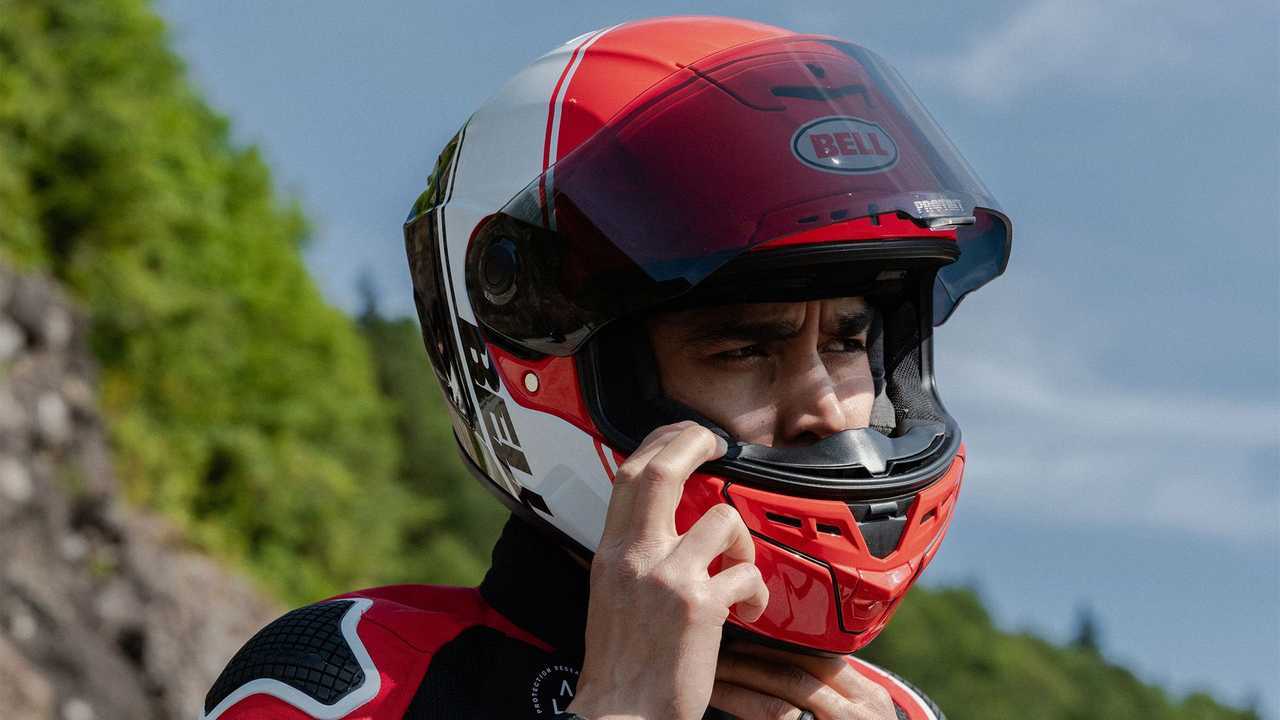
The Bell Star debuted as the world’s first full-face helmet in 1966. The California-based company wasn’t going to let its flagship helmet become a one-hit wonder either. Just nine years later, in 1975, the Bell Star II introduced the first flip-up visor system to the market. That innovative spirit still lives on today, with Bell expanding the technologically-advanced Star into a full-fledged lineup.
At the head of the family table, the Bell Pro Star and Race Star Flex DLX hold court. With Grand Prix- and Superbike-proven pedigree to its name, the Race Star distills today’s latest protective technologies into a race-ready helmet. A three-layer Flex impact liner, Bell’s Raceview profile, and a 3K carbon fiber shell leave no doubts about the Race Star’s track ambitions. Not everyone is looking for a sharp-edged, dedicated race helmet, though.
The Bell Star DLX MIPS reconfigures the platform's base algorithm for part-time road use. Out goes the carbon fiber construction; in comes a Tri-Matrix composite shell. A MIPS (Multi-directional Impact Protection System) liner substitutes for Bell’s Flex technology while the Streetview eye port yields better vision from an upright vantage point.
Those minor alterations bring the Star’s asking price down to $549.95 (Summit livery: $589.95), saving customers a considerable chunk of change over the $819.95 Race Star. The Star siblings may share a family resemblance on the outside, but they’re completely unique under the skin. Does that render the standard Bell Star a shell of its bigger brother, though? We took to the street and the circuit to answer just that.
In The Streets

The Bell Star may not hold the same track credentials as the Race Star, but you wouldn’t know as much by looking at the Summit color scheme. Favoring simplicity over aggression, retro over modern, the straightforward yet sporty graphics communicate the model’s racy background. The included Panovision ProTint Photochromatic (DLX) shield frequently supplements that all-business aesthetic by automatically tinting under direct sunlight.
The versatile visor also pays off when the sun sets or the rider moseys through a long unlit tunnel. Of course, the shield requires several one-alligator counts to adjust to low-lighting conditions, but it never dims deep enough to leave the user stumbling in the dark. While the ProTint Photochromatic function deftly adapts to ambient light levels, the visor locking system seems unsophisticated by comparison.

With a simple latch at the bottom, the shield clasps onto the edge of the helmet’s chin bar. It easily locks into place with a sturdy thunk, but opening the shield proves anything but effortless. I frequently needed both hands to unhook the stubborn latch, making shield flips on the go practically impossible. Despite that clunky visor lock, the Panovision shield mechanism makes visor swaps a breeze. An innovative shield release button streamlines the process, allowing riders to quickly switch to a non-transition shield or a Pinlock-equipped (not included) unit.
Completing the helmet’s alphabet soup of a name is the MIPS liner. As with all MIPS helmets, the Star’s Brain Protection System (BPS) lies between the EPS (expanded polystyrene) layers and head liner. Should the rider go down, the BPS and inner lining remain secure on the head as the EPS and outer shell rotate around them. This sliding protective membrane mitigates impact and torsional forces, shielding the rider from concussions and even brain damage.


Fortunately, I don’t have any experiential data to provide on this front, but the energy management system helps the Bell Star achieve DOT and Snell certifications. I may not have needed MIPS to protect my brain but it sure eased my mind. One area that wasn’t as comforting, however, was the helmet’s fit. Bell lists the Star as an intermediate oval shape, but I found it slightly narrow at the temples and longer front to back.
The thinly-padded top liner doesn’t help with those accommodations either. Pressure points never resulted but the Star is far from a cozy, all-day touring helmet. Luckily, the cheek pads and neck roll provide sufficient padding, and when paired with the removable wind curtain, seal out most wind noise. Customers can swap out the cheek pads and interior liner for a custom fit, but I recommend trying on the Star before pulling the trigger.
On The Track

The Bell Star holds up on the road but it’s in its element on the closed course. Fitment issues never cause a row during 20-to-40-minute track intervals, and the snug fit adds an extra dose of reassurance. Bell knows that ventilation is key on the circuit, with a large chin bar intake, a brow inlet, a crown vent, and two rear exhaust ports (passive and active) supplying sufficient airflow.
When the mercury rose to 102 degrees (F) at Rosamond, California’s Willow Springs International Speedway, the Star’s airways met their thermal match. Thankfully (for me), the removable chin curtain, breath guard, and chin vent plug opened those breezy channels even further. As one would expect, wind noise amplified as the airflow increased. Most track riders wear earplugs, though, which help deaden those harmful decibels.
Gallery: Bell Star DLX MIPS Summit Helmet







The Star may feature Bell’s Streetview eye-port, but visibility on the track never suffers. The wide lateral field of view keeps battling riders in your peripheral while the tall visor preserves vision in full tuck. I already have a dedicated track day helmet, but the Bell Star’s voluminous ventilation and widescreen visor present an intriguing counterargument.
Conclusion
No, the Bell Star doesn’t boast the Race Star's Virus Cool Jade Power mesh liner. It may not earn a trick carbon fiber shell or Magnefusion magnetic cheek pads. Doesn’t it really need any of those fancy features, though? That’s a negative, Ghost Rider. When it comes to everyday canyon rips and occasional track days, the Bell Star completes the mission—and it does so at a fraction of the cost.


Within the mid-tier segment, the model separates itself from the competition with its MIPS safety system, Panovision ProTint Photochromatic, and ample air circulation. It may not rise to the heights (or price) of the Pro Star or Race Star, but the Bell Star DLX MIPS lives up to the Bell Star legacy with roadway sensibility and track-ready performance.







